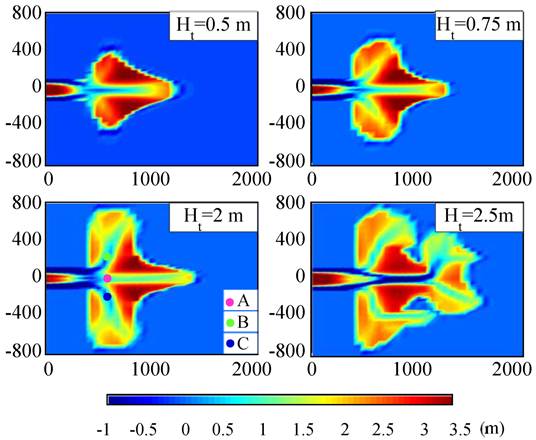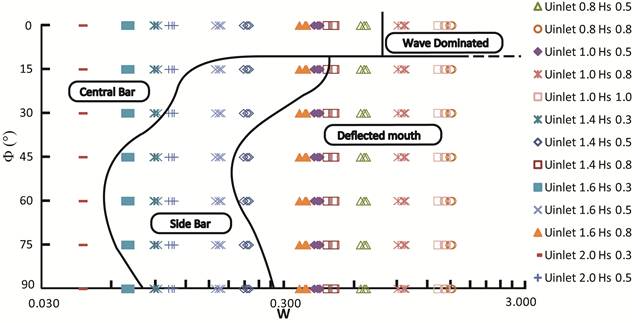57th Annual Report on Research 2012 Under Sponsorship of the ACS Petroleum Research Fund
Reports: ND851128-ND8: Evolution of Mouth Bars and Salt Marshes in Deltas: Implications for Sedimentary Deposits and Stratigraphy
Sergio Fagherazzi, Boston University
In Fiscal year 2011/2012 we focused our research activity on modeling mouth bar formation in deltas under the effect of waves and tides. The theoretical and conceptual results obtained from the numerical experiments will provide important preliminary information for the instruments deployment that will be carried out in winter 2013 in Apalachicola Bay, Florida
1. Growth and evolution of river mouth bars in shallow bays under frontal wave attack
One of the key processes for the formation of deltas and their fluvial networks is the deposition of mouth bars in front of prograding distributaries. Waves influence mouth bar growth, but it is not clear how and to what extent. Towards this end we have conduct a modeling study on deltas forming in shallow bays, where waves are locally generated and both longshore currents and surf zone absent. We focus on the simplified case of a homopycnal river plume subject to frontal wave attack, and we begin by isolating the effects of waves on jet spreading. An analytical model for the hydrodynamic interaction between incoming waves and a turbulent expanding jet is developed and tested with the numerical modelDelft3D coupled to the wave model SWAN.
The model indicates that incoming surface gravity waves increase the spreading rate of the jet and the interaction between wave and current boundary layers causes an increase in bottom friction. Our numerical results show that in presence of waves, mouth bars form up to 35% closer to the river mouth and 40% faster when compared to cases without waves. The distance from the river mouth to the stagnated mouth bar decreases with increasing wave height and wave period. Our modeling study suggests that wave influence on mouth bar growth is a complex, non-monotonic function. Small waves, like the ones modeled here, promote mouth bar formation via increased jet spreading and decreased formation time, which in turn should create deltas with more distributary channels. On the contrary, large waves suppress mouth bar formation, as seen in other studies, leading to fewer distributary channels.
Figure 1. Contour lines of depth-averaged velocity for two jet exiting a river mouth with basin depth of 3 m and 6 m. Continuous lines are for flow and dashed lines are for flow with waves, Hs = 0.5 m and Tp = 5 s. The presence of waves increases the jet spreading, which leads to a reduction of the longitudinal velocity and an increase of the transverse one (after Nardin et al. submitted).
2. Effect of tides on mouth bar morphology and hydrodynamics
River mouth bars significantly contribute to the development of deltas. Several external drivers affect the formation of these deposits. This paper focuses on the role of tides on shaping mouth bars, presenting both hydrodynamic and morphodynamic results. The effect of tides is analyzed in two end-member configurations: a river with a small tidal prism compared to the fluvial discharge (fluvial dominated), and a river with very large tidal prism (tidal dominated). Mouth bar formation is analyzed using the coupled hydrodynamic and morphodynamic model Delft3D. The presence of tides influences the hydrodynamic of the jet exiting the river mouth. The resulting velocity field is characterized by residual currents that affect the growth and the final shape of the mouth bar. Our analysis shows that tides cause mouth bars widening. Moreover, a large tidal prism leads to the formation of a central channel typical of tidal inlets. Simulations indicate that bars are characterized by the presence of two channels for negligible tidal prisms, whereas three principal channels are present in the tidal dominated case.
Figure 2. Formation of a mouth bar under the effect of different tidal ranges. Ht is the tidal semi-amplitude (after Leonardi et al. submitted).
3. The effect of wind waves direction on the development of river mouth bars
River deltas are among the most important environments on earth, housing productive ecosystems and a large fraction of the human population. The key process for delta development is the deposition of mouth bars in front of delta distributaries. Predicting mouth bar formation on marine coastlines is complex because of the interactions between waves, tides, water and sediment discharge. Here we study the effects of waves on mouth bar growth with the coupled
sediment transport and wave model Delft3D-SWAN. Our results show that wave characteristics (height, period, and direction) play an important role in the formation of mouth bars. In our numerical experiments waves affect bar development in three ways: by modifying the direction of the river jet, by increasing bottom shear stresses at the river mouth, and by changing bottom friction and hence increasing jet spreading. We further show that high waves with long
period prevent the formation of mouth bars; in particular, wave angles between 45o and 60o are the least favorable to bar formation, likely producing a deflected river mouth.
Figure 3. Phase space plot of mouth bar morphology as a function of the ratio between wave and river bottom shear stresses (parameter W) and wave angle Φ. Each area identifies a specific morphology of deposited sediments. Different peak period (Tp = 5, 8, 10s) for each velocity and wave height are showed (after Nardin et al 2012).
4. Impact on the career of the PI and graduate students
This PRF grant allowed me to start a new research direction on the morphological evolution and stratigraphy of deltas. In the near future a large fraction of my time and resources will be devoted on this new topic. We have already three manuscript published or submitted with the numerical simulations performed in the first year. A tighter collaboration with ongoing research projects at major oil companies (Exxon-Mobil and Chevron) will be possible because of this grant. A PhD thesis and a MS thesis originated from the first year results. The graduate students are currently advancing in their career seeking a PhD degree and working as a Postdoctoral associate Both students are working on similar research topics.













